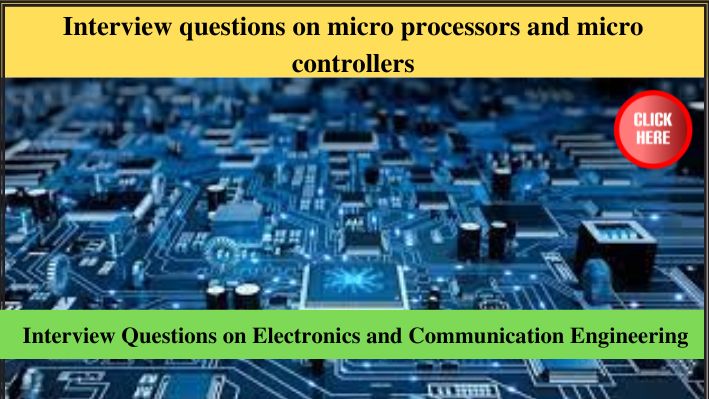Interview questions on microprocessors and microcontrollers
Hello, In this blog, We will discuss Interview questions on microprocessors and microcontrollers, These questions are asked in many interviews repeatedly, Please read all the interview questions, and Feel free to ask doubts or suggestions on it
Interview questions on microprocessors and microcontrollers
What is a microprocessor and how does it differ from a microcontroller?
A microprocessor is a central processing unit (CPU) on a single integrated circuit that can perform arithmetic and logic operations. It is a general-purpose device that requires external components to perform specific tasks. A microcontroller, on the other hand, is a small computer on a single integrated circuit that includes a microprocessor, memory, and input/output (I/O) peripherals. A microcontroller is designed to perform specific tasks, making it a more integrated and efficient solution for embedded systems.
What are the different types of microprocessors?
The different types of microprocessors include:
8-bit microprocessors
16-bit microprocessors
32-bit microprocessors
64-bit microprocessors
What is the clock speed of a microprocessor and why is it important?
The clock speed of a microprocessor is the frequency at which it executes instructions. It is usually measured in megahertz (MHz) or gigahertz (GHz). The clock speed is important because it directly affects the processing power of a microprocessor. A higher clock speed means that the microprocessor can perform more operations per second.
What is the purpose of a memory controller in a microprocessor?
The memory controller is responsible for managing the communication between the microprocessor and the system memory. It acts as an interface between the two, ensuring that data is transferred between them efficiently and accurately. The memory controller also manages the access to the memory, ensuring that multiple requests for memory access are properly managed and executed.
What are the key components of a microcontroller and what are their functions?
The key components of a microcontroller include:
CPU: Performs arithmetic and logic operations
Memory: Stores data and program instructions
I/O peripherals: Provide interfaces for communication with external devices
Timers: Provide timing and counting functions
Interrupt controller: Manages and prioritizes interrupt requests
Some more Interview questions on microprocessors and microcontrollers (Part-1)
What are the different types of memory in a microcontroller and what is their purpose?
The different types of memory in a microcontroller include:
ROM: Read-only memory that stores program instructions that cannot be altered
RAM: Random-access memory that stores temporary data
EEPROM: Electrically erasable programmable read-only memory that can be programmed and reprogrammed multiple times
What is the purpose of an interrupt in a microcontroller and how does it work?
An interrupt is a signal that temporarily stops the normal execution of a program and transfers control to a special routine called an interrupt service routine (ISR). Interrupts are used to handle external events such as input from a user, data from a sensor, or communication with another device. When an interrupt occurs, the microcontroller stops its current operation, saves its current state, and transfers control to the ISR. After the ISR has finished, the microcontroller restores its previous state and resumes its normal operation.
What is the difference between Harvard and Von Neumann architecture?
The Harvard architecture has separate memory spaces for instructions and data, while the Von Neumann architecture has a single memory space for both instructions and data. The Harvard architecture allows for concurrent access to instructions and data, making it faster and more efficient. The Von Neumann architecture, on the other hand, is simpler and requires less memory.
Can you explain the instruction set of a microprocessor?
The instruction set of a microprocessor is the set of instructions that it can understand and execute. It includes basic arithmetic and logical operations, as well as instructions for controlling the flow of a program, accessing memory, and interacting with peripherals. The instruction set is specific to each microprocessor and defines its capabilities and limitations.
Part-2:
How does a microcontroller conserve power in battery-powered applications?
In battery-powered applications, power conservation is crucial to ensure that the device runs for a long time on a single battery charge. Microcontrollers have several features that help conserve power, including:
Sleep modes: The microcontroller can be put into a low-power sleep mode when it is not performing any tasks, reducing its power consumption
Clock gating: The clock signal to a particular module can be stopped when it is not needed, reducing its power consumption
Power-saving peripherals: Peripherals can be designed to operate in a low-power mode when not in use
Can you explain what an ADC (Analog-to-Digital Converter) does and why it is important in a microcontroller system?
An ADC is a peripheral that converts an analog signal to a digital signal. It is used to interface analog devices, such as sensors, with a digital microcontroller. The ADC measures the analog input voltage and converts it into a digital value that the microcontroller can understand and process. The ADC is important because it allows the microcontroller to interact with analog devices and perform analog-to-digital conversions, which is essential for many applications such as data acquisition, signal processing, and control systems.
What is the difference between parallel and serial communication in microcontroller systems?
Parallel communication involves transferring multiple bits of data at the same time, while serial communication involves transferring one bit of data at a time. Parallel communication is faster but requires more wires and pins, while serial communication is slower but requires fewer wires and pins. Microcontrollers typically have both parallel and serial communication interfaces, allowing them to communicate with a variety of devices and systems.
Part-3:
What is an interrupt in a microcontroller system?
An interrupt is a signal sent to the microcontroller that temporarily stops its current operation and transfers control to a specific interrupt service routine. Interrupts are used to handle external events, such as a button press or incoming data, and are a key mechanism for handling real-time events in microcontroller systems. Interrupts are important because they allow the microcontroller to respond to external events without constantly checking for them, improving system responsiveness and efficiency.
What is the purpose of a timer in a microcontroller system?
A timer is a peripheral in a microcontroller that generates periodic signals or counts events. Timers are used for several purposes, including:
Measuring time intervals: A timer can be used to measure the time between two events or the duration of an event.
Generating periodic signals: A timer can be used to generate periodic signals for tasks such as generating a clock signal or controlling the frequency of a PWM signal.
Controlling software execution: A timer can be used to schedule software tasks to run at specific intervals.
Part-4:
What is the difference between a microprocessor and a microcontroller?
A microprocessor is a programmable device that can execute instructions and perform arithmetic and logic operations. A microcontroller is a microprocessor with built-in peripherals and memory, designed to control specific systems. Microprocessors are typically used in larger systems, while microcontrollers are used in small, embedded systems. Microcontrollers are more integrated and have lower power consumption compared to microprocessors.
Can you explain what a DMA (Direct Memory Access) controller does and why it is important in a microcontroller system?
A DMA controller is a peripheral that allows data to be transferred between memory and peripherals without involving the microcontroller. This frees up the microcontroller to perform other tasks, improving system performance and efficiency. A DMA controller can transfer data in the background while the microcontroller is performing other tasks, reducing the workload of the microcontroller and reducing system latency. The use of a DMA controller is important in microcontroller systems where high-speed data transfer is required, such as in multimedia applications or data acquisition systems.
Interview questions on satellite communication
Conclusion: I hope this blog, Interview questions on microprocessors and microcontrollers helpful to you, For more interview questions on different subjects, Visit our main website Digital Tech Fact



